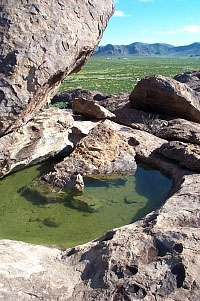
Hueco, the Spanish word for hollow, refers to the numerous circular depressions and deep natural cisterns that pock the four massive rock outcroppings at the park. During the rainy season, the huecos hold rainwater, attracting a variety of animals. Photo courtesy of Texas Parks and Wildlife Department.  |
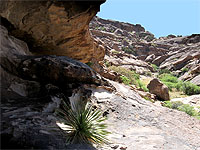
Canyons and overhangs provided shelter and diverse resources for Native people in the past as well as broad canvases for expressions of art and ritual. Photo by Susan Dial.  |
| Encompassed under the rubric 41EP2—the official site designation for Hueco Tanks—are 29 archeological "localities" and more than 270 pictograph panels bearing evidence of the many different cultures who made the area their home. |
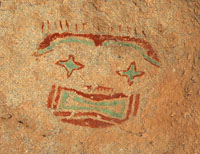
A unique depiction of a star-eyed face utilizes blue/green pigment, perhaps made from ground turquoise or cuprous material. Photo by Rupestrian Cyberservices, courtesy of Texas Parks and Wildlife.  |
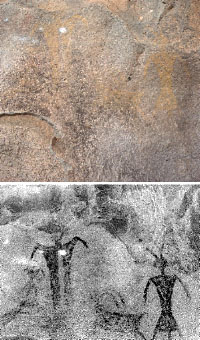
After computer enhancement, ghostly figures emerge in a photograph of a weathered, apparently blank canyon wall (top). Technical enhancements such as these have added dozens of previously unknown pictograph images to the park inventory. Photo by Rupestrian Cyberservices, courtesy of Texas Parks and Wildlife Department.  |
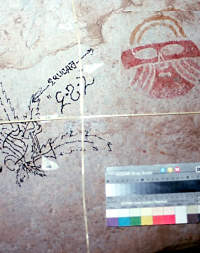
Modern graffiti, painted dangerously close to a unique red and yellow mask pictograph, mars a canyon wall. Prior to cleaning, volunteers documented the panel using a string grid and color chart. Photo courtesy of Texas Parks and Wildlife Department.  |
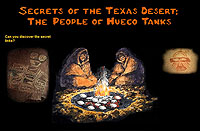
A set of lively and educational K-12 activities, "Secrets of the Desert: The Lost People of Hueco Tanks," allows students to discover the site's cultural history and geography.  |
|
Near the northwestern tip of the Texas Trans-Pecos, some 30 miles east of El Paso,four massive hills of jumbled boulders rise above the desert floor. No doubt this prominent and oddly compelling landmark has had many different names through time. Today it is known as Hueco Tanks. Characterized as an island in the desert, a natural oasis, a spiritual sanctuary, the site has meant many things to many people.
For thousands of years, Native peoples camped here among the hills, drawing on the site's diverse plant and animal resources. Some stayed longer than others, finding a way to eke out a living in the arid Chihuahuan desert. Roughly 900 years ago, people of the Jornada Mogollon culture built a small village and grew corn and other crops in the soils that accumulated at the base of the rocks. More recently, the site was operated as a cattle ranch, among the first and largest in the region. Following several recreational developments, the property became a county park, and finally a state park. The site today still remains a special place for many Native American peoples who find a spiritual connection here.
What attracted people to this place through time was the critical resource needed for sustaining life on the desert—water. The huge red rocks and boulders are cracked and pocked with fissures and holes—huecos—that trap and hold rainwater for months at a time. The location of these natural tanks was known and, in some cases, marked with special symbols and inscriptions on the rocks. For Native peoples, water in the desert must have seemed a special gift, and there is little doubt that this gift was commemorated in ritual expression through time.
Hundreds of paintings—from large panels to small mask-like faces—adorn the canyon walls, overhangs, ceilings of shelters, and small, hard to find places at the site. Unlike the massive displays at rock art sites along the Texas Lower Pecos or in the greater American Southwest, many of the Hueco Tanks pictographs seem to have been deliberately hidden from view. This puzzling aspect, along with the unusual motifs, has provoked substantial debate over the meaning and derivation of the symbols. Researchers also have discovered that there are many more images at the park than meet the eye. Using new computer techniques, photographers have been able to identify and recapture hundreds of faded or previously unknown pictographs. The inventory of masks now numbers more than 200, constituting the largest assemblage of painted masks in North America.
For archeologists, Hueco Tanks State Park is not one but many archeological sites. Encompassed under the rubric 41EP2—the official site designation—are 29 archeological "localities" and more than 270 rock imagery panels bearing evidence of the many different cultures who made the area their home. Some traces amount to little more than scatters of stone toolmaking debris, where hunters may have stopped to resharpen tools and weapons. Others are the remains of campsites with hearths or "ovens" where ancient cooks roasted desert plants. At the small village site, archeologists found traces of small pithouse structures containing hearths and burials. The first structures of their time period in the Hueco Bolson to be excavated, they have provided important evidence about the architectural transition from simple huts to the multi-room pueblos characteristic of later times.
Archeologists, historians, artists, and photographers have tracked and painstakingly documented the often ephemeral cultural remains at this 860-acre park. Part of their challenge, and that of the Hueco Tanks staff, has been to preserve and protect the fragile cultural remains and remarkable rock art imagery while allowing visitors to explore and enjoy the park.
Through the years, visitors and vandals have left their marks on the walls at some of the park's most significant locales. Some painted graffiti over ancient rock art; others inscribed their names and date of their visit, a tradition going back to the 1840s. Striking a balance between public access and preservation of the site's irreplaceable cultural treasures is an ongoing challenge, managed in recent years by capping the number of visitors at a time, showing every visitor an orientation video, and providing entry to certain areas only when accompanied by a trained guide.
In the following sections, we explore the many realms of Hueco Tanks and provide a virtual tour of some of its most unusual, and often most inaccessible, sites. In Natural Setting: A Rocky Oasis on the Desert, we describe the site's distinctive environment and diverse natural resources. Data from packrat middens and other evidence helps us reconstruct the environment of the past and is presented in the Paleoclimate section. In Explorations and Investigations, we trace early accounts of the site and the work that has been done to uncover the cultural history of Hueco Tanks. The Rock Art Imagery section provides a look at some of the most significant examples of Native expression in North America as well as the modern techniques being used to recapture art that has been destroyed by weathering or human activity. This section also includes a gallery of watercolor depictions of Hueco Tanks rock art painted by noted artist Forrest Kirkland in the 1930s. Weaving the Story: The People of Hueco Tanks chronicles the various peoples who have come to this place. Hueco Tanks Village: A Culture in Transition takes a more detailed look at the small agricultural settlement, as revealed through archeolgical excavations and recent research.
In the interactive Kids section, "Secrets of the Desert: The People of Hueco Tanks," Dr. Dirt, the Armadillo Archeologist, introduces K-12 audiences to Trans-Pecos geography, cultural history, and the whys and hows of living in the desert. Included are a timeline and guided tour of pictograph panels and other special places.
|
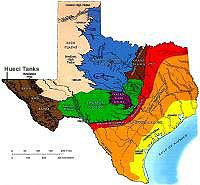
Physiographic map of Texas showing location of Hueco Tanks in the Basin and Range region of Texas. The site is located roughly 30 miles east of El Paso. Map courtesy Bureau of Economic Geology, University of Texas at Austin.  |
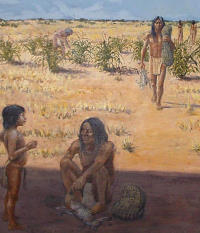
Prehistoric "farmers" adapted to desert conditions by planting corn, beans, and other crops in moisture retentive soils. Inset from reconstructed scene by George Nelson, courtesy of the Institute for Texan Cultures.  |
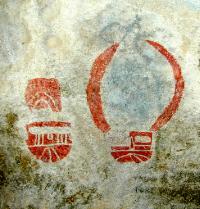
More than 3000 pictographs, including unusual mask-like depictions such as these, adorn canyon walls and appear in hidden places throughout the park. Many are attributed to the Jornada Mogollon culture, including the farming peoples who lived at the park roughly 850 years ago. Photo by Rupestrian Cyberservices, courtesy of Texas Parks and Wildlife Department.  |
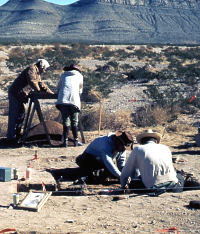
Texas Parks and Wildlife archeologists excavated the remains of a pithouse village, the home of desert farmers some 850 years ago. Traces of the small structures have provided important evidence about the architectural transition from pithouse dwellings to multi-room pueblos. Photo courtesy Texas Parks and Wildlife Department.  |
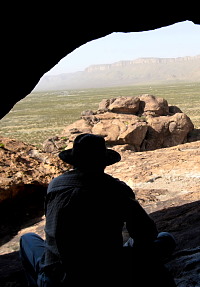
Perched within a high shelter, a park visitor looks out over the broad basin and the Hueco Mountains in the distance. The challenge for park staff is to maintain a tight balance between allowing public access and protecting the site's unique resources. Photo by Susan Dial.  |
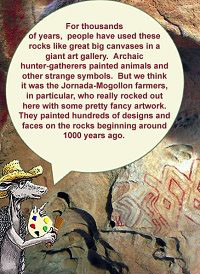
Dr. Dirt, the Armadillo Archeologist reveals some of the secrets of Hueco Tanks for young audiences.  |
|












